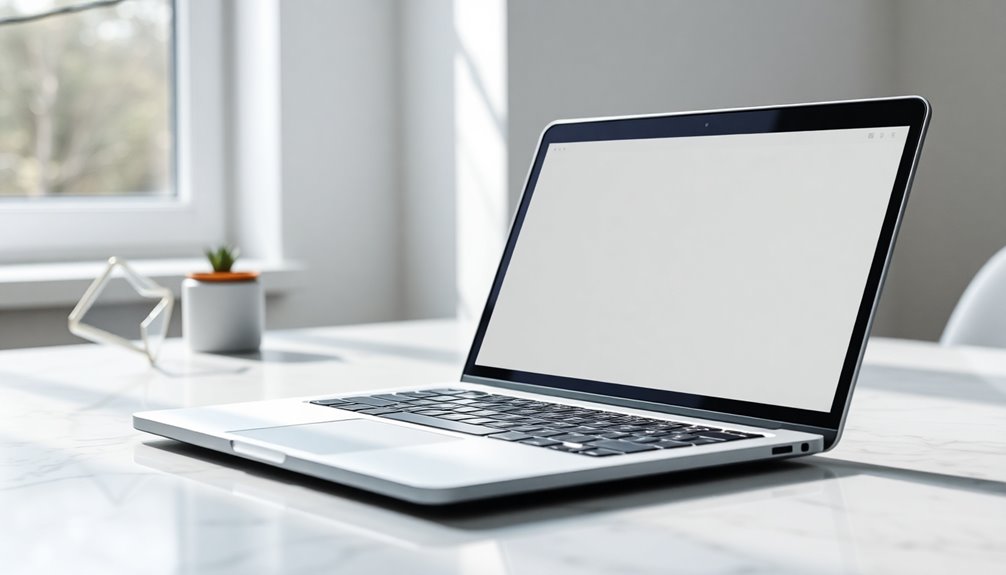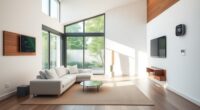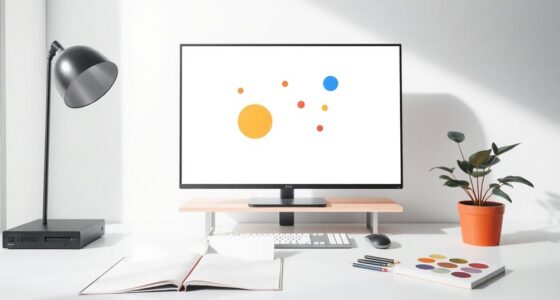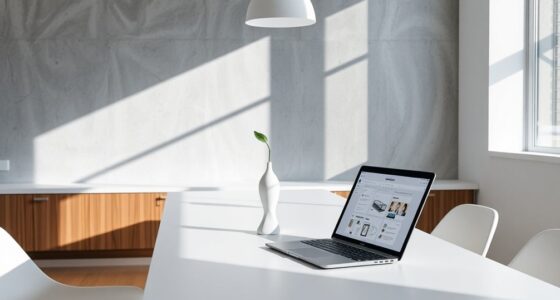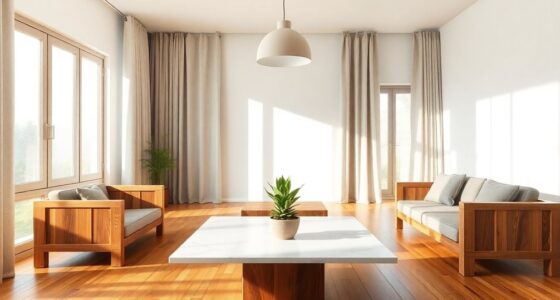Recent minimalist web design innovations prioritize user experience by embracing simplicity and intentional elements. You'll find intuitive navigation that reduces clutter, strategic whitespace enhancing readability, and clean typography ensuring visual cohesion. Finally, engaging micro-interactions and AI-driven personalization provide interactive experiences tailored to user preferences. The trend towards dark mode and unique color schemes adds modern flair while maintaining calm visuals. Keep exploring to uncover more exciting developments in minimalist design.
Key Takeaways
- AI-driven personalization tailors minimalist web designs to individual user preferences, enhancing engagement and user satisfaction.
- Dark Mode designs are gaining popularity, reducing eye strain while maintaining a sleek aesthetic.
- Unique color schemes, including gradients, add visual interest without cluttering the minimalist approach.
- Incorporating micro-interactions enhances user engagement and satisfaction by providing feedback during actions.
- Non-traditional scrolling techniques redefine user interaction, making navigation more dynamic and engaging in minimalist designs.
Understanding Minimalist Web Design
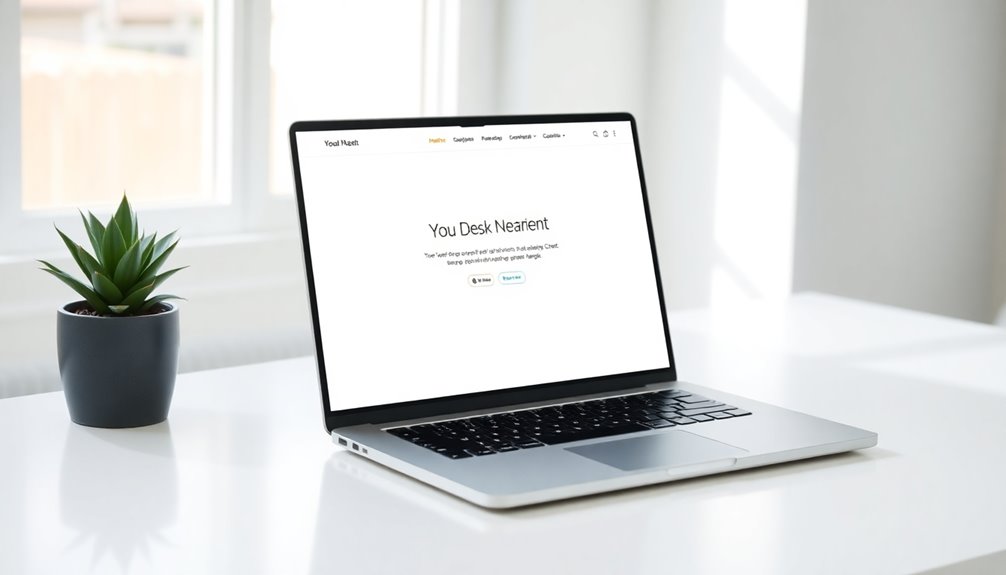
Understanding Minimalist Web Design
Why does minimalist web design resonate so deeply with both designers and users? It's all about meeting user needs while keeping things simple.
By embracing the "less is more" philosophy, minimalist design reduces cognitive load, allowing you to focus on essential content rather than distracting visual elements. The generous use of whitespace creates breathing room, making navigation intuitive and pleasant.
Plus, with fewer components to load, you'll enjoy fast load times, enhancing overall user experience.
Designers appreciate how this approach fosters visual cohesion through purposeful typography and a limited color palette.
Ultimately, minimalist web design not only streamlines the browsing experience but also aligns perfectly with today's fast-paced digital environment. Additionally, it encourages continuous optimization based on user behavior, ensuring that the design evolves alongside user needs.
Key Elements of Minimalist Design

While minimalist design might seem simple at first glance, it incorporates several key elements that work together to create an effective user experience.
By embracing minimalist principles, you'll notice the use of generous whitespace, which allows content to breathe and enhances focus. This leads to intuitive navigation, making it easier for you to find the information you seek without feeling overwhelmed.
Embracing minimalist design fosters intuitive navigation and enhances focus through generous whitespace, simplifying your search for information.
Clean aesthetics are achieved through a limited color palette, maintaining visual cohesion while guiding your attention toward essential elements.
Finally, typography plays an important role; selecting clean, readable fonts establishes a clear visual hierarchy and guides you through the content.
Together, these elements reduce clutter and improve usability, making your experience more enjoyable and efficient. Additionally, understanding the importance of color palette selection can further enhance the minimalist aesthetic in web design.
Core Principles of Minimalist Design

Minimalist design thrives on the principle of simplicity, ensuring that every element on a page has a clear purpose. This intentional approach reduces cognitive load, allowing users to focus on what truly matters.
By utilizing whitespace strategically, you create visual breathing room that enhances clarity and draws attention to essential content. Limited color palettes foster visual cohesion, guiding users' eyes toward key areas of the website without distraction.
Effective typography plays a vital role in this design philosophy; clean, readable fonts help navigate content and align with your brand identity.
Ultimately, these core principles work together to elevate user experience, making interactions intuitive and enjoyable while maintaining an uncluttered aesthetic. Additionally, the integration of AI technologies can further enhance user interactions by personalizing experiences based on visitor behavior.
Benefits of Minimalist Web Design
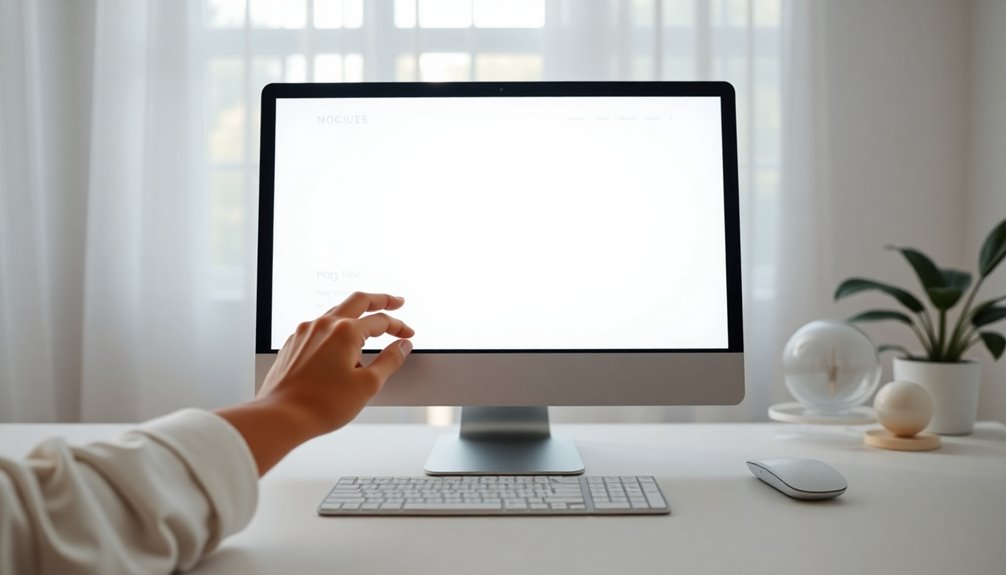
When you embrace minimalist web design, you release a range of benefits that enhance user experience and engagement. By reducing cognitive load, users can focus on essential content without distractions. This leads to higher satisfaction and engagement levels. Plus, minimalist websites typically achieve faster load times, improving performance and search engine rankings. Additionally, users appreciate energy-saving features that contribute to a more efficient experience while interacting with the site.
Here's a quick overview of the benefits:
| Benefit | Description | Impact |
|---|---|---|
| Enhance User Experience | Reduces distractions, allowing focus on content | Increased engagement |
| Faster Load Times | Fewer elements result in quicker page loads | Better performance |
| Visual Appeal | Generous white space improves readability | Stronger brand image |
Best Practices for Implementing Minimalism
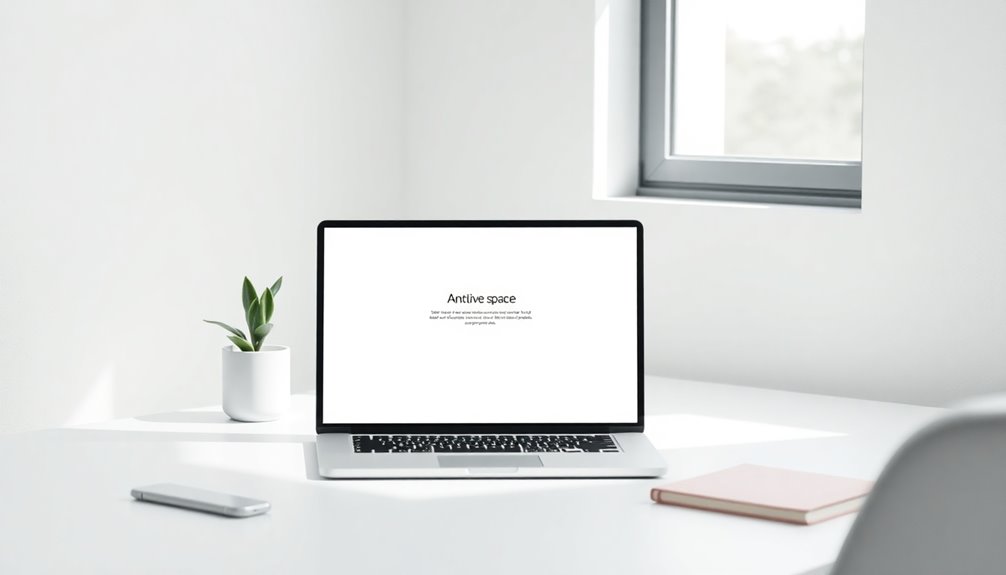
To effectively implement minimalism in your web design, start by embracing white space, allowing your content to breathe and enhance user experience.
Prioritize readable typography that fits your brand, ensuring visitors can easily engage with your content.
Finally, limit your color palette to maintain visual cohesion and guide users' attention where it matters most. Additionally, consider how user preferences can influence the overall design effectiveness and user satisfaction.
Embrace White Space
White space serves as a powerful design tool that greatly enhances user experience. By embracing ample white space, you improve visual clarity and reduce cognitive load, allowing users to focus on essential features without distractions. A strategic application of white space guides the viewer's eye, enhancing overall user engagement by up to 20%.
| Benefit | Description | Impact on Design Philosophy |
|---|---|---|
| Visual Clarity | Reduces clutter | Creates a clean, inviting interface |
| User Engagement | Invites interaction | Increases time spent on site |
| Intuitive Navigation | Delineates sections | Enhances content organization |
| Aesthetic Appeal | Fosters pleasing design | Influences brand perception |
| Readability | Improves text flow | Keeps users focused |
Utilizing white space effectively leads to a more engaging design experience. Additionally, color accuracy plays a significant role in enhancing visual appeal, making it essential for minimalist web designs to consider how colors interact with white space.
Prioritize Readable Typography
Prioritizing readable typography is vital for guaranteeing that users can easily engage with your content. Choosing clean sans serif fonts enhances legibility and aligns with your overall design aesthetic, fostering a better user experience.
Limit yourself to one or two font styles to maintain visual harmony and avoid overwhelming your audience. Effective font size and weight create a clear hierarchy, guiding users through your content while emphasizing key information without clutter.
Generous line and letter spacing can greatly enhance readability, particularly on mobile devices where screen space is tight. Remember, testing typography across various devices is essential, especially since nearly 50% of web traffic comes from mobile users. Incorporating diversification strategies in your content can also help to attract a broader audience by appealing to diverse user preferences.
This approach guarantees your design prioritizes readability and accessibility.
Limit Color Palette
Limiting your color palette is essential for achieving a minimalist web design that captivates users without overwhelming them. A palette of two to five colors creates visual cohesion and enhances the design's user experience. Opt for monochromatic or analogous color schemes to maintain simplicity while evoking emotions that guide user behavior. Consistent use of your limited color palette across pages boosts brand recognition—75% of consumers judge a brand based solely on color. Additionally, the concept of visual cohesion can be seen in culinary practices, such as how butter enhances flavor and moisture in baked goods.
| Color Scheme Type | Benefits |
|---|---|
| Monochromatic | Simplicity and elegance |
| Analogous | Harmony and visual appeal |
| Complementary | Dynamic contrast |
| Neutral | Versatility and subtlety |
Tools like Coolors and Adobe Color can help you refine your choices.
The Role of Interactive Elements
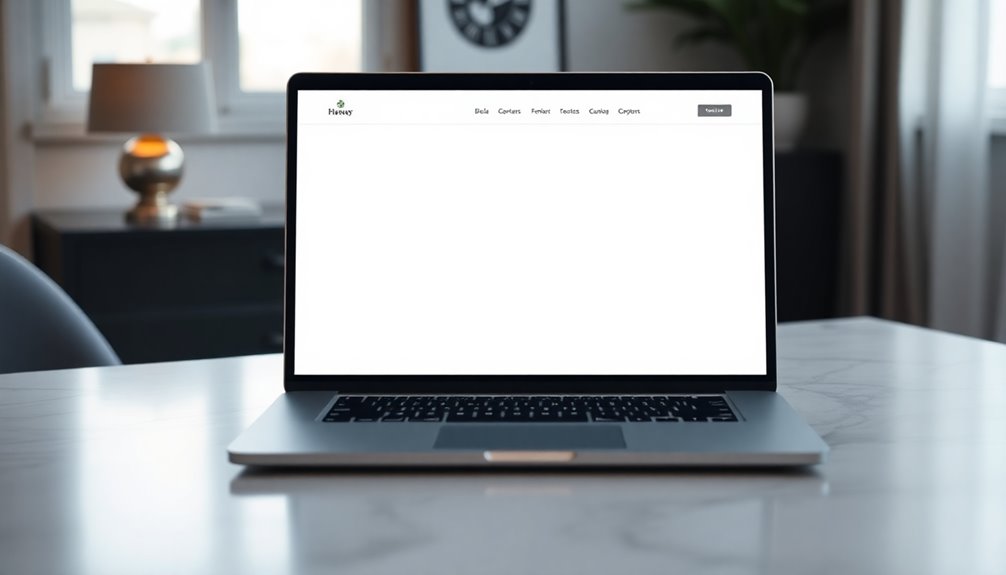
How can interactive elements transform a minimalist web design into an engaging experience? By incorporating features like budgeting calculators and storytelling through rich media, you create a more immersive experience that enhances user engagement.
These interactive elements draw users in, making them feel connected to your content. Small interactions, such as color bursts and sliding scales, keep users interested and encourage longer visits to your minimalist website.
Interactive elements create a connection with users, keeping them engaged and encouraging longer visits to your minimalist website.
Scroll-triggered animations can reveal content gradually, enhancing storytelling while enthralling users. Plus, incorporating micro-interactions, like animated buttons or progress indicators, provides subtle feedback that improves user-friendliness and satisfaction.
Ultimately, these features not only enrich the browsing experience but also foster a sense of connection, leading to higher user retention rates. Additionally, AI-driven personalization can tailor these interactive elements to individual user preferences, further enhancing engagement and satisfaction.
Integrating Micro-Interactions
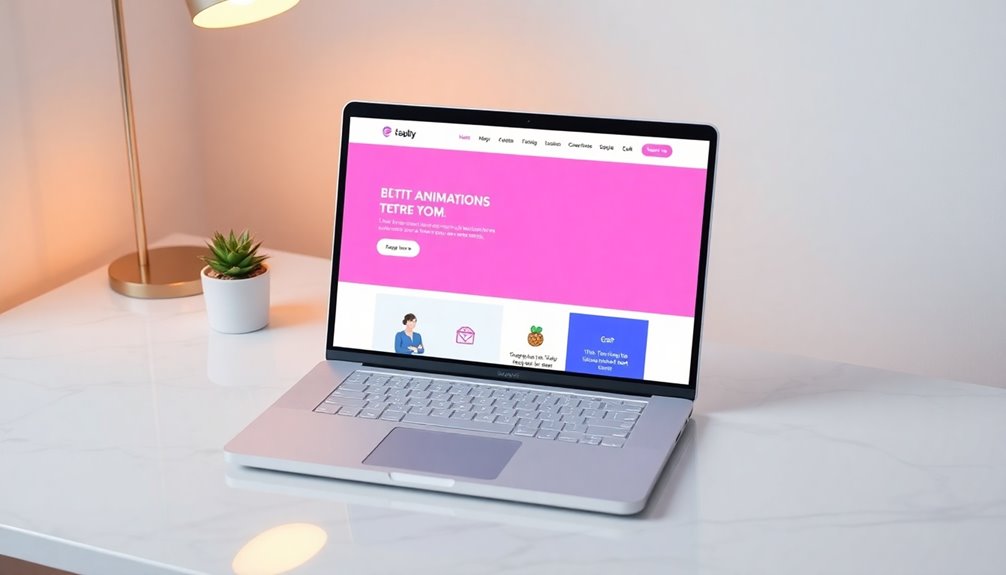
Micro-interactions can transform your minimalist web design by enhancing user engagement and improving navigation flow.
With subtle animations, you can provide feedback that keeps users informed without cluttering the interface. Additionally, implementing well-structured content can further improve readability and user experience, making micro-interactions even more effective.
Enhancing User Engagement
What makes a website truly engaging? Micro-interactions play an essential role in enhancing user engagement. By incorporating elements like hover effects and progress indicators, you provide immediate visual feedback, helping users grasp the impact of their actions.
This approach not only boosts user satisfaction—studies show a 70% increase—but also creates a dynamic browsing experience that 80% of users appreciate. In minimalist web design, these subtle enhancements keep focus on essential content while preventing a static feel.
Furthermore, well-designed micro-interactions can improve conversion rates by up to 30%, guiding users toward actions like signing up for newsletters or completing purchases.
Ultimately, integrating micro-interactions elevates the overall user experience and retention.
Subtle Animation Techniques
While browsing a website, you might not realize how much subtle animation techniques enhance your experience. Micro-interactions provide essential feedback during actions like button clicks, making the site feel more responsive. When used wisely, these lightweight animations can boost user engagement and retention by up to 30%. Here's a quick look at effective subtle animation techniques:
| Animation Type | Purpose | Example |
|---|---|---|
| Loading Indicators | Indicate progress | Spinning wheel |
| Hover Effects | Highlight interactive areas | Button color change |
| Animated Changes | Smooth transitions | Fade-in effects |
| Feedback Animations | Confirm actions | Checkmark display |
| Scroll Animations | Guide content flow | Parallax effects |
Implementing these animations aligns with the minimalist ethos, ensuring fast load times without distraction.
Improving Navigation Flow
To enhance your website's navigation flow, consider integrating micro-interactions that provide immediate visual cues.
These subtle animations or feedback responses can greatly improve user engagement, guiding visitors seamlessly through your site. Simple effects, like hover animations or loading indicators, reduce cognitive load, making minimalist designs more user-friendly.
Studies show that interactive elements can boost click-through rates by up to 30%, emphasizing their importance in modern web design.
Additionally, consistent micro-interactions reinforce brand identity, creating a unique visual language that enhances the overall user experience.
Research indicates that 70% of users remember brands that use engaging micro-interactions, making them an essential component for improving navigation flow and ensuring better user retention on your website.
Future Trends in Minimalist Web Design
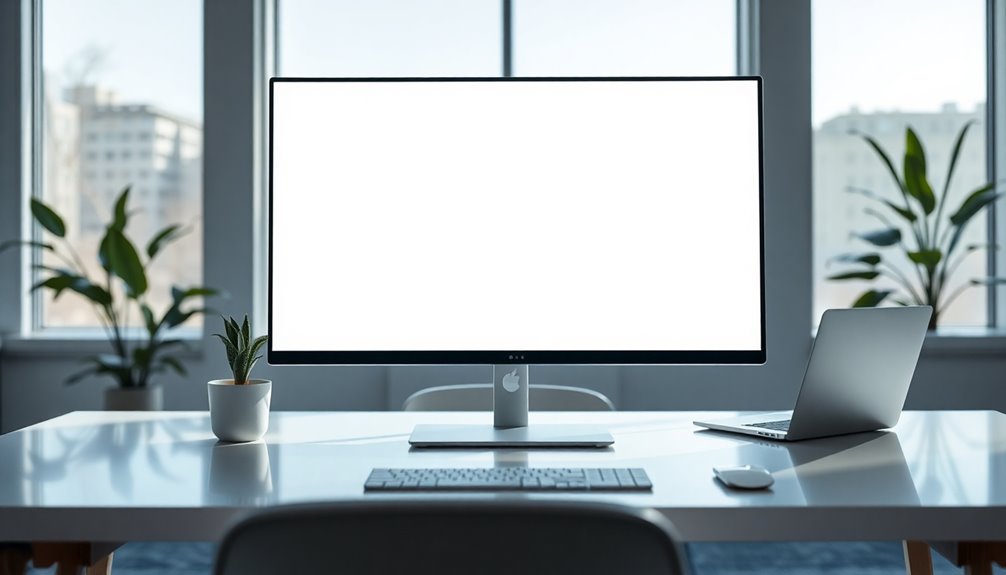
As technology evolves, minimalist web design is set to embrace exciting innovations that enhance user experience without cluttering the interface. One major trend is AI-driven personalization, which tailors content to your preferences while keeping a clean aesthetic.
You'll also see a shift towards dynamic visuals, like micro-interactions and engaging animations, that make sites more interesting without overwhelming you. Dark Mode designs are on the rise, offering modern aesthetics and reducing eye strain, aligning perfectly with minimalist principles.
Unique color schemes, including gradients and duotones, create fascinating visuals while maintaining simplicity. Furthermore, non-traditional scrolling techniques, such as horizontal scrolling and parallax effects, redefine user engagement, ensuring that minimalist web design remains fresh and appealing.
Tools and Resources for Minimalist Designers
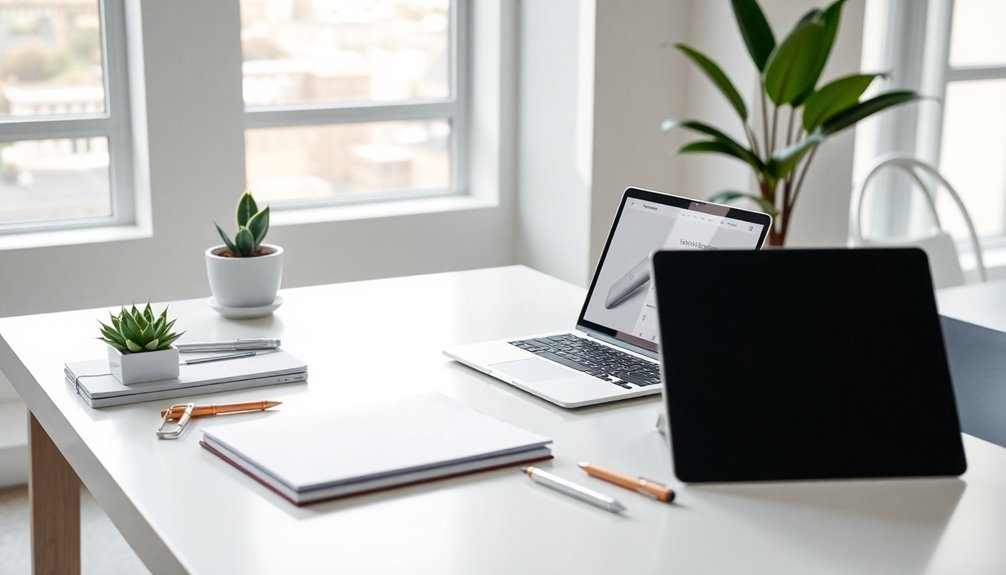
Five essential tools can elevate your minimalist design projects and streamline your workflow.
Start with design software like Figma, Sketch, or Adobe XD, which enable wireframing and prototyping focused on clean layouts and user functionality.
Utilize design software such as Figma, Sketch, or Adobe XD for streamlined wireframing and prototyping that prioritizes clarity and user experience.
For color selection, tools like Coolors and Paletton help you choose cohesive, minimal hues that enhance visual simplicity and maintain brand consistency.
Google Fonts offers a range of clean typography options, ensuring readability and aesthetic appeal for your minimalist websites.
Don't forget performance optimization tools like Lighthouse, which assess speed, accessibility, and SEO.
Finally, resource selection tools allow you to balance aesthetic simplicity with functional design, ensuring every element serves a purpose and enhances the user experience without clutter.
Real-World Examples of Minimalist Websites
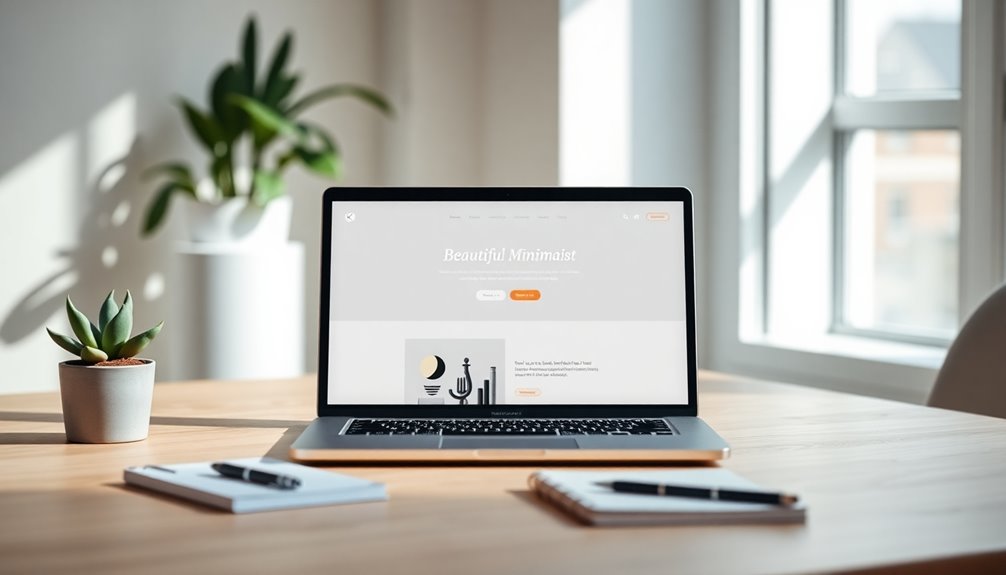
Minimalist websites stand out not only for their aesthetic appeal but also for their functionality, making them a popular choice among users. Examples include:
| Website | Features |
|---|---|
| Apple | Ample white space, clean typography, high-quality images |
| Dropbox | Simple color palette, clear call-to-action buttons |
| Straightforward layout, minimal distractions |
These sites illustrate core principles of minimalist design, integrating intentional simplicity with effective user interfaces. Apple focuses on visual appeal through product imagery, while Dropbox reduces cognitive load with intuitive navigation. Google's design emphasizes functionality, allowing users to concentrate on searching. Airbnb highlights listings with strategic negative space, and Medium enhances readability using simple typography.
Frequently Asked Questions
How Does Minimalist Design Impact Website Loading Speeds?
Minimalist design profoundly impacts website loading speeds by reducing the amount of content and elements on the page.
When you streamline visuals and limit the use of heavy graphics, your site loads faster, providing a better user experience.
You're also likely to see improved SEO rankings since search engines favor quicker loading sites.
Can Minimalist Design Work for E-Commerce Websites?
Think of minimalist design for e-commerce websites like a clear, open road inviting you to drive faster.
Yes, it can definitely work! By stripping away distractions, you focus on the products, making it easier for customers to navigate and find what they want.
Clean layouts and essential features enhance the shopping experience, leading to higher conversions.
What Are Common Mistakes in Minimalist Web Design?
Common mistakes in minimalist web design often stem from oversimplifying elements. You might remove too much content, leaving users confused about navigation.
Forgetting to maintain a balanced color palette can also make your site feel bland.
Additionally, ignoring mobile responsiveness can alienate users on smaller screens.
Ultimately, not considering the hierarchy of information can lead to important details being overlooked.
Aim for simplicity, but guarantee clarity and functionality remain intact.
How Do I Balance Aesthetics and Functionality in Minimalist Design?
Imagine a serene landscape, where every element serves a purpose.
To balance aesthetics and functionality in minimalist design, focus on clean lines and ample white space. Use a limited color palette to evoke emotion while ensuring easy navigation.
Prioritize essential features that enhance user experience without cluttering the interface. Keep your typography simple yet striking, making your message clear.
Are There Specific Color Palettes for Minimalist Websites?
Yes, there are specific color palettes that work well for minimalist websites.
You'll want to stick to a few neutral tones like whites, grays, and beiges, which create a clean backdrop.
Adding one or two accent colors can help draw attention without overwhelming the design.
Soft pastels or bold primary colors can work, depending on your brand.
Just remember to keep it simple and cohesive to maintain that minimalist aesthetic.
Conclusion
In a world of web design, less truly is more. By embracing the elegance of minimalist design, you can create clear, enchanting, and compelling experiences for users. Focus on function, foster fluidity, and fine-tune your visuals to maximize impact. As you navigate the nuances of this approach, remember that simplicity sparks satisfaction. So, immerse yourself in the vibrant domain of minimalist web design, and let your creativity flourish with finesse and flair.
